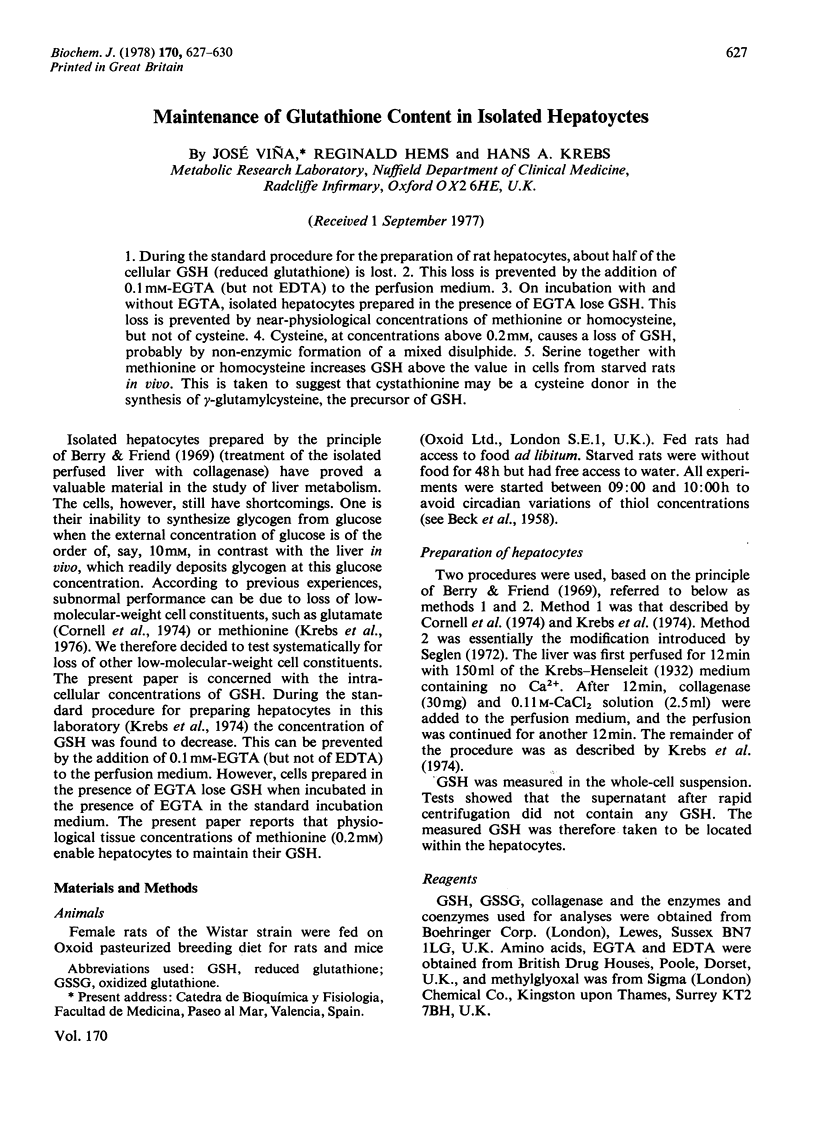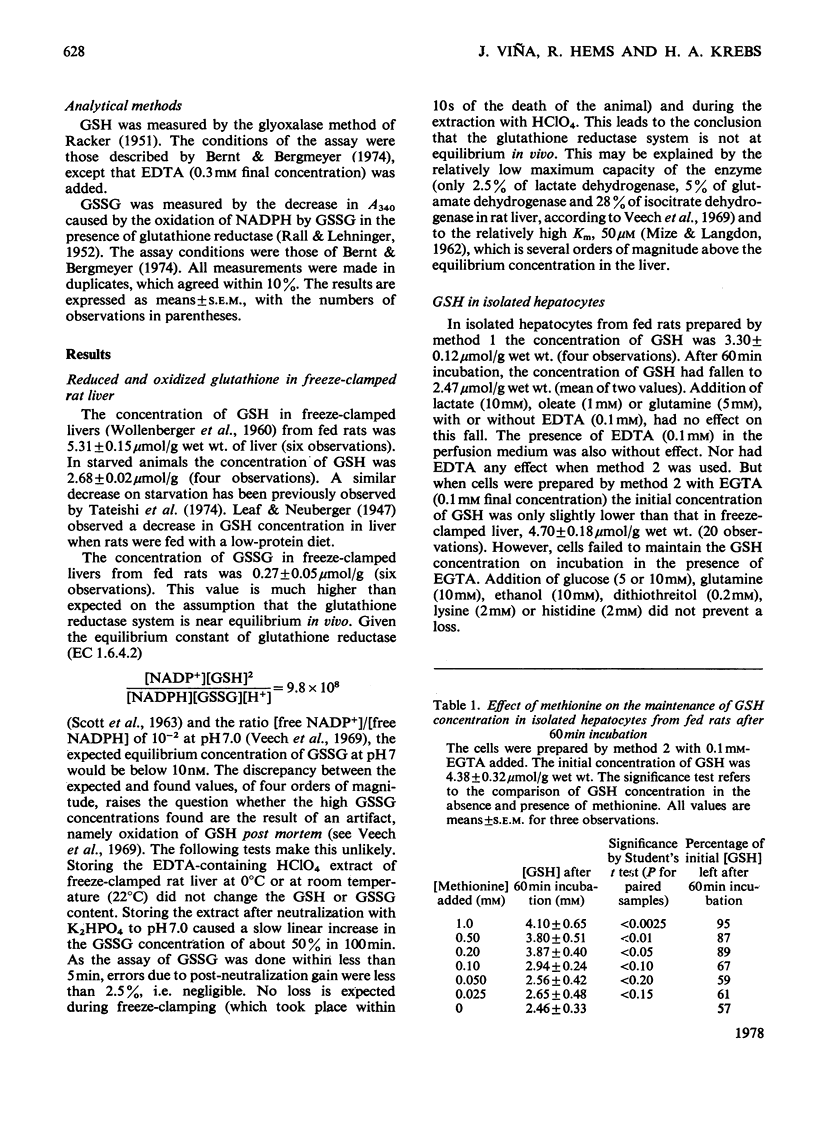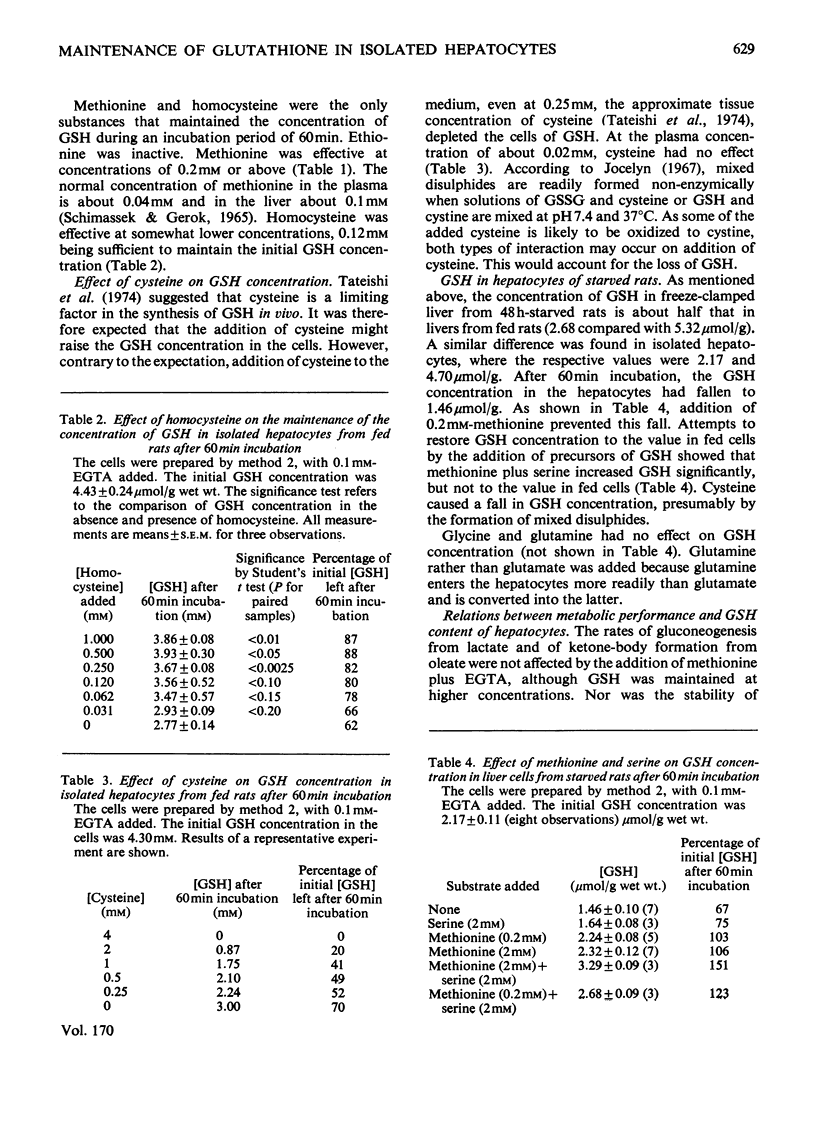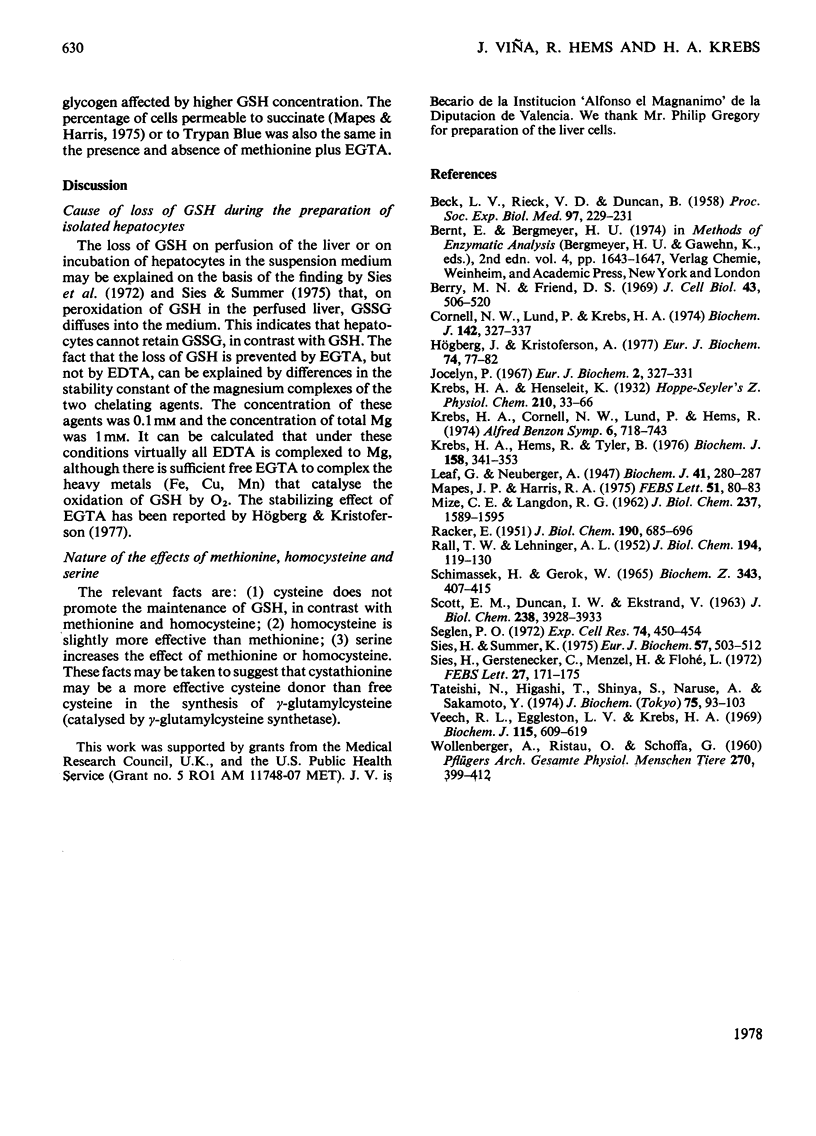Abstract
1. During the standard procedure for the preparation of rat hepatocytes, about half of the cellular GSH (reduced glutathione) is lost. 2. This loss is prevented by the addition of 0.1 mM-EGTA (but no EDTA) to the perfusion medium. 3. On incubation with and without EGTA, isolated hepatocytes prepared in the presence of EGTA lose GSH. This loss is prevented by near-physiological concentrations of methionine or homocysteine, but not of cysteine. 4. Cysteine, at concentrations above 0.2 mM, causes a loss of GSH probably by non-enzymic formation of a mixed disulphide. 5. Serine together with methionine or homocystein increases GSH above the value in cells from starved rats in vivo. This is taken to suggest that cystathionine may be a cysteine donor in the synthesis of gamma-glutamylcysteine, the precursor of GSH.
Full text
PDF



Selected References
These references are in PubMed. This may not be the complete list of references from this article.
- BECK L. V., RIECK V. D., DUNCAN B. Diurnal variation in mouse and rat liver sulfhydryl. Proc Soc Exp Biol Med. 1958 Jan;97(1):229–231. doi: 10.3181/00379727-97-23698. [DOI] [PubMed] [Google Scholar]
- Berry M. N., Friend D. S. High-yield preparation of isolated rat liver parenchymal cells: a biochemical and fine structural study. J Cell Biol. 1969 Dec;43(3):506–520. doi: 10.1083/jcb.43.3.506. [DOI] [PMC free article] [PubMed] [Google Scholar]
- Cornell N. W., Lund P., Krebs H. A. The effect of lysine on gluconeogenesis from lactate in rat hepatocytes. Biochem J. 1974 Aug;142(2):327–337. doi: 10.1042/bj1420327. [DOI] [PMC free article] [PubMed] [Google Scholar]
- Högberg J., Kristoferson A. A correlation between glutathione levels and cellular damage in isolated hepatocytes. Eur J Biochem. 1977 Mar 15;74(1):77–82. doi: 10.1111/j.1432-1033.1977.tb11368.x. [DOI] [PubMed] [Google Scholar]
- Jocelyn P. C. The standard redox potential of cysteine-cystine from the thiol-disulphide exchange reaction with glutathione and lipoic acid. Eur J Biochem. 1967 Oct;2(3):327–331. doi: 10.1111/j.1432-1033.1967.tb00142.x. [DOI] [PubMed] [Google Scholar]
- Krebs H. A., Hems R., Tyler B. The regulation of folate and methionine metabolism. Biochem J. 1976 Aug 15;158(2):341–353. doi: 10.1042/bj1580341. [DOI] [PMC free article] [PubMed] [Google Scholar]
- Leaf G., Neuberger A. The effect of diet on the glutathione content of the liver. Biochem J. 1947;41(2):280–287. [PMC free article] [PubMed] [Google Scholar]
- MIZE C. E., LANGDON R. G. Hepatic glutathione reductase. I. Purification and general kinetic properties. J Biol Chem. 1962 May;237:1589–1595. [PubMed] [Google Scholar]
- Mapes J. P., Harris R. A. On the oxidation of succinate by parenchymal cells isolated from rat liver. FEBS Lett. 1975 Mar 1;51(1):80–83. doi: 10.1016/0014-5793(75)80858-1. [DOI] [PubMed] [Google Scholar]
- RACKER E. The mechanism of action of glyoxalase. J Biol Chem. 1951 Jun;190(2):685–696. [PubMed] [Google Scholar]
- RALL T. W., LEHNINGER A. L. Glutathione reductase of animal tissues. J Biol Chem. 1952 Jan;194(1):119–130. [PubMed] [Google Scholar]
- SCOTT E. M., DUNCAN I. W., EKSTRAND V. PURIFICATION AND PROPERTIES OF GLUTATHIONE REDUCTASE OF HUMAN ERYTHROCYTES. J Biol Chem. 1963 Dec;238:3928–3933. [PubMed] [Google Scholar]
- Schimassek H., Gerok W. Control of the levels of free amino acids in plasma by the liver. Biochem Z. 1965 Dec 31;343(4):407–415. [PubMed] [Google Scholar]
- Seglen P. O. Preparation of rat liver cells. I. Effect of Ca 2+ on enzymatic dispersion of isolated, perfused liver. Exp Cell Res. 1972 Oct;74(2):450–454. doi: 10.1016/0014-4827(72)90400-4. [DOI] [PubMed] [Google Scholar]
- Sies H., Gerstenecker C., Menzel H., Flohé L. Oxidation in the NADP system and release of GSSG from hemoglobin-free perfused rat liver during peroxidatic oxidation of glutathione by hydroperoxides. FEBS Lett. 1972 Oct 15;27(1):171–175. doi: 10.1016/0014-5793(72)80434-4. [DOI] [PubMed] [Google Scholar]
- Sies H., Summer K. H. Hydroperoxide-metabolizing systems in rat liver. Eur J Biochem. 1975 Sep 15;57(2):503–512. doi: 10.1111/j.1432-1033.1975.tb02325.x. [DOI] [PubMed] [Google Scholar]
- Tateishi N., Higashi T., Shinya S., Naruse A., Sakamoto Y. Studies on the regulation of glutathione level in rat liver. J Biochem. 1974 Jan;75(1):93–103. doi: 10.1093/oxfordjournals.jbchem.a130387. [DOI] [PubMed] [Google Scholar]
- Veech R. L., Eggleston L. V., Krebs H. A. The redox state of free nicotinamide-adenine dinucleotide phosphate in the cytoplasm of rat liver. Biochem J. 1969 Dec;115(4):609–619. doi: 10.1042/bj1150609a. [DOI] [PMC free article] [PubMed] [Google Scholar]
- WOLLENBERGER A., RISTAU O., SCHOFFA G. [A simple technic for extremely rapid freezing of large pieces of tissue]. Pflugers Arch Gesamte Physiol Menschen Tiere. 1960;270:399–412. [PubMed] [Google Scholar]


